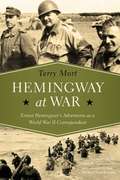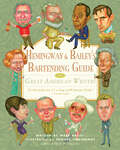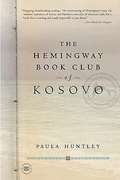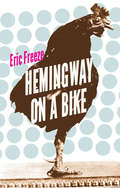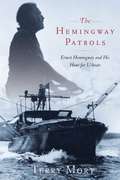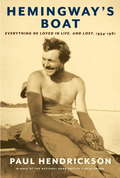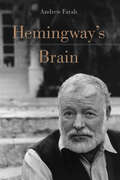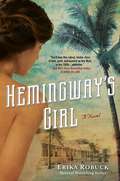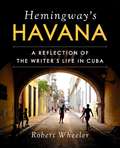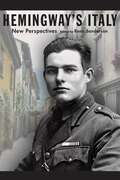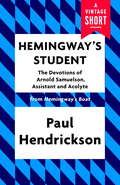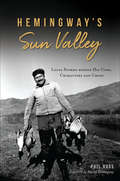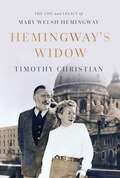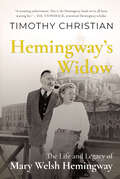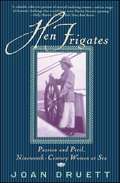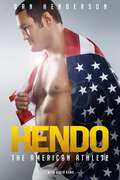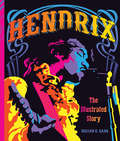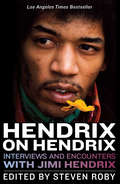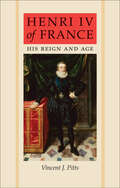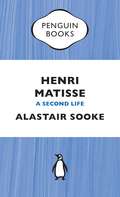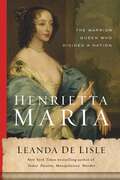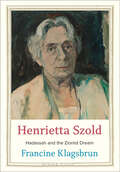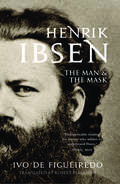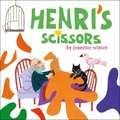- Table View
- List View
Hemingway at War: Ernest Hemingway's Adventures as a World War II Correspondent
by Terry MortFrom Omaha Beach on D-Day and the French Resistance to the tragedy of Huertgen Forest and the Liberation of Paris, this is the story of Ernest Hemingway's adventures in journalism during World War II. In the spring of 1944, Hemingway traveled to London and then to France to cover World War II for Colliers Magazine. Obviously he was a little late in arriving. Why did he go? He had resisted this kind of journalism for much of the early period of the war, but when he finally decided to go, he threw himself into the thick of events and so became a conduit to understanding some of the major events and characters of the war. He flew missions with the RAF (in part to gather material for a novel); he went on a landing craft on Omaha Beach on D-Day; he went on to involve himself in the French Resistance forces in France and famously rode into the still dangerous streets of liberated Paris. And he was at the German Siegfried line for the horrendous killing ground of the Huertgen Forest, in which his favored 22nd Regiment lost nearly man they sent into the fight. After that tragedy, it came to be argued, he was never the same. This invigorating narrative is also, in a parallel fashion, an investigation into Hemingway’s subsequent work—much of it stemming from his wartime experience—which shaped the latter stages of his career in dramatic fashion.
Hemingway & Bailey's Bartending Guide to Great American Writers
by Mark Bailey Edward HemingwayIn this entertaining homage to the golden age of the cocktail, illustrator Edward Hemingway and writer Mark Bailey present the best (and thirstiest) American writers, their favorite cocktails, true stories of their saucy escapades, and intoxicating excerpts from their literary works. It’s the perfect blend of classic cocktail recipes, literary history, and tales of the good old days of extravagant Martini lunches and delicious excess. When Algonquin Round Table legend Robert Benchley was asked if he knew that drinking was a slow death, Benchley took a sip of his cocktail and replied, “So who’s in a hurry?” Hunter S. Thompson took Muhammad Ali’s health tip to eat grapefruit every day; he just added liquor to the mix. Invited to a “come as you are” party, F. Scott Fitzgerald and his wife, Zelda, arrived in their pajamas ready for their cocktail of choice: a Gin Rickey. Forty-three classic American writers, forty-three authentic cocktail recipes, forty-three telling anecdotes about the high life, and forty-three samples of the best writing in literature –Hemingway & Bailey’s Bartending Guide to Great American Writers delivers straight-up fun.
The Hemingway Book Club of Kosovo
by Paula HuntleyIn August 2000, Paula Huntley's husband took a leave of absence from his teaching post at a law school, and she resigned from her marketing job of thirteen years. Huntley's husband had signed on with the American Bar Association to help rebuild Kosovo's legal system. Not quite sure how she could be of any service in a country that had suffered so much, Huntley found a position at a private school teaching English to a group of Kosovo Albanians. In this inspiring diary of her experiences in Kosovo, Huntley describes the deep friendships she formed with her students and the remarkable book club that they created . . . One day in a bookstore in Prishtina, Huntley stumbled upon a copy of Hemingway's Old Man and the Seaand-judging that it was just the right reading level and length--she made copies of it for the group. Despite lingering concerns that this quintessential American writer so notorious for his machismo might not resonate, the story of the old man's struggle to bring in his big fish touched them deeply. So deeply in fact that, though the group went on to read other great American writers, a name for their club was born: The Hemingway Book Club of Kosovo. This book reveals both the fragility and strength of the human spirit. Neither a journalist nor a historian, Huntley describes her students' experiences during the war and the intimacy of the bond that she formed with them with a rare purity and directness. A vision of great hope, The Hemingway Book Club of Kosovoreveals the power of human connection to bring about healing in even the most war-torn circumstances.
Hemingway on a Bike
by Eric FreezeA collage-like mash-up of personal anecdote, popular culture, masculinity, sports, and parenting, Hemingway on a Bike takes readers through the many and varied twists and turns of the life and mind of its author, Eric Freeze. Delving into obsessions and experiences, Freeze’s essays display a keen intelligence with insights on topics as diverse as Mormonism and foosball, Angry Birds and professional wrestling, superheroes and freebirthing, Ernest Hemingway and Star Trek.“Carnecopia” mashes experiences fishing and snorkeling with an exhibit at Monaco’s oceanographic museum to comment on how human beings unwittingly enact harm on their environment. “Bolt” explores the author’s fascination with sprinting and shares moments in France and the Midwest, where the words “to bolt” sometimes have unforeseen consequences. “Supergirl” plays on the childhood fascination with superheroes juxtaposed with adulthood manifestations of gendered expectations.By turns playful, poignant, celebratory, and searching, Hemingway on a Bike meanders through ruminations on a number of subjects, and these reflections combine to dissect identity, belonging, and migration in an age when borders and boundaries, whatever the type, are continually transgressed and traversed.
The Hemingway Patrols
by Terry MortA fascinating account of a dramatic, untold chapter in Ernest Hemingway's life -- his passionate pursuit of German U-boats during World War II From the summer of 1942 until the end of 1943, Ernest Hemingway actively patrolled the Gulf Stream and the waters off Cuba's north shore in his wooden fishing boat, Pilar, looking for German submarines. His patrols were supervised by the U.S. Navy and served as a part of antisubmarine warfare at a time when U-boat attacks were decimating Allied merchant shipping in the region. The huge, long-distance subs ultimately sank hundreds of ships in the Atlantic theater, killing thousands of seamen. They were deadly and efficient, and to confront them in a small wooden fishing vessel was to court instant annihilation. Yet Hemingway and his crew of friends were prepared to do just that. Armed with only grenades and submachine guns, they planned to attack any U-boat they encountered. While almost no attention has been paid to these patrols, other than casual mentions in standard biographies, they became the foundation of some of Hemingway's future work, especially The Old Man and the Sea and Islands in the Stream. Onshore, the patrols were a source of mounting friction between Hemingway and his wife, the writer Martha Gellhorn, who was brilliant, difficult, and skeptical of Hemingway's pursuit. Martha was not particularly beautiful but possessed that certain something that drove men -- Hemingway included -- to distraction. He had divorced his second wife to marry Martha, and yet by the time he began patrolling in Pilar, the love affair was doomed, perhaps pushing him more intently toward a confrontation with the U-boats. Terry Mort's incisive portrait of Hemingway is a combination of biography, military history, and literary commentary that draws not only from his work, letters, and wartime documents, but the unofficial yet highly revealing log of the Pilar, a calendar that Hemingway annotated with observations of tides, fishing successes, supply purchases, target practice, ship movements, and most crucially, his pursuit of what he suspected was a German U-boat secretly rendezvousing with a Spanish passenger ship. Hemingway's patrols gave him the opportunity to exercise his well-known taste for bravado, tall tales, and male camaraderie. But he was at the top of his professional game when World War II began, a novelist with wealth, international acclaim, and many works ahead of him. Mort's provocative portrait of one of America's greatest writers reveals why he went to sea and courted death in the high season of his most remarkable life.
Hemingway's Boat: Everything He Loved in Life, and Lost, 1934-1961
by Paul HendricksonFrom a National Book Critics Circle Award winner, a brilliantly conceived and illuminating reconsideration of a key period in the life of Ernest Hemingway that will forever change the way he is perceived and understood.<P> Focusing on the years 1934 to 1961—from Hemingway’s pinnacle as the reigning monarch of American letters until his suicide—Paul Hendrickson traces the writer’s exultations and despair around the one constant in his life during this time: his beloved boat, Pilar.<P> We follow him from Key West to Paris, to New York, Africa, Cuba, and finally Idaho, as he wrestles with his best angels and worst demons. Whenever he could, he returned to his beloved fishing cruiser, to exult in the sea, to fight the biggest fish he could find, to drink, to entertain celebrities and friends and seduce women, to be with his children. But as he began to succumb to the diseases of fame, we see that Pilar was also where he cursed his critics, saw marriages and friendships dissolve, and tried, in vain, to escape his increasingly diminished capacities.<P> Generally thought of as a great writer and an unappealing human being, Hemingway emerges here in a far more benevolent light. Drawing on previously unpublished material, including interviews with Hemingway’s sons, Hendrickson shows that for all the writer’s boorishness, depression, and alcoholism, and despite his choleric anger, he was capable of remarkable generosity—to struggling writers, to lost souls, to the dying son of a friend.<P> We see most poignantly his relationship with his youngest son, Gigi, a doctor who lived his adult life mostly as a cross-dresser, and died squalidly and alone in a Miami women’s jail. He was the son Hemingway forsook the least, yet the one who disappointed him the most, as Gigi acted out for nearly his whole life so many of the tortured, ambiguous tensions his father felt. Hendrickson’s bold and beautiful book strikingly makes the case that both men were braver than we know, struggling all their lives against the complicated, powerful emotions swirling around them. As Hendrickson writes, “Amid so much ruin, still the beauty.”<P> Hemingway’s Boat is both stunningly original and deeply gripping, an invaluable contribution to our understanding of this great American writer, published fifty years after his death.
Hemingway's Brain
by Andrew FarahA forensic psychiatrist’s second opinion on the conditions that led to Ernest Hemingway’s suicide, “mixing biography, literature and medical analysis” (The Washington Post).Hemingway’s Brain is an innovative biography and the first forensic psychiatric examination of Nobel Prize–winning author Ernest Hemingway. After seventeen years researching Hemingway’s life and medical history, Andrew Farah, a forensic psychiatrist, has concluded that the writer’s diagnoses were incorrect. Contrary to the commonly accepted diagnoses of bipolar disorder and alcoholism, he provides a comprehensive explanation of the medical conditions that led to Hemingway’s suicide.Hemingway received state-of-the-art psychiatric treatment at one of the nation’s finest medical institutes, but according to Farah it was for the wrong illness, and his death was not the result of medical mismanagement but medical misunderstanding. Farah argues that despite popular mythology Hemingway was not manic-depressive and his alcohol abuse and characteristic narcissism were simply pieces of a much larger puzzle. Through a thorough examination of biographies, letters, memoirs of friends and family, and even Hemingway’s FBI file, combined with recent insights on the effects of trauma on the brain, Farah pieces together this compelling alternative narrative of Hemingway’s illness, one missing from the scholarship for too long.Though Hemingway’s life has been researched extensively and many biographies written, those authors relied on the original diagnoses and turned to psychoanalysis and conjecture regarding Hemingway’s mental state. Farah has sought to understand why Hemingway’s decline accelerated after two courses of electroconvulsive therapy, and in this volume explains which current options might benefit a similar patient today. Hemingway’s Brain provides a full and accurate accounting of this psychiatric diagnosis by exploring the genetic influences, traumatic brain injuries, and neurological and psychological forces that resulted in what many have described as his tortured final years. It aims to eliminate the confusion and define for all future scholarship the specifics of the mental illnesses that shaped legendary literary works and destroyed the life of a master.
Hemingway's Girl
by Erika Robuck"She remembered when Hemingway had planted a banyan tree at his house and told her its parasitic roots were like human desire. At the time she'd thought it romantic. She hadn't understood his warning."In Depression-era Key West, Mariella Bennet, the daughter of an American fisherman and a Cuban woman, knows hunger. Her struggle to support her family following her father's death leads her to a bar and bordello, where she bets on a risky boxing match...and attracts the interest of two men: world-famous writer, Ernest Hemingway, and Gavin Murray, one of the WWI veterans who are laboring to build the Overseas Highway. When Mariella is hired as a maid by Hemingway's second wife, Pauline, she enters a rarified world of lavish, celebrity-filled dinner parties and elaborate off-island excursions. As she becomes caught up in the tensions and excesses of the Hemingway household, the attentions of the larger-than-life writer become a dangerous temptation...even as straightforward Gavin Murray draws her back to what matters most. Will she cross an invisible line with the volatile Hemingway, or find a way to claim her own dreams? As a massive hurricane bears down on Key West, Mariella faces some harsh truths...and the possibility of losing everything she loves.
Hemingway's Havana: A Reflection of the Writer's Life in Cuba
by Robert Wheeler América FuentesErnest Hemingway lived in Cuba for more than two decades, longer than anywhere else. He bought a home—naming it the Finca Vigia—with his third wife, Martha Gellhorn and wrote his masterpiece The Old Man and the Sea there. In Cuba, Papa Hemingway found a sense of serenity and enrichment that he couldn’t find anywhere else. Now, through more than a hundred color photographs and accompanying text, Robert Wheeler takes us through the streets and near the water’s edge of Havana, and closer to the relationship Hemingway shared with the Cuban people, their landscape, their politics, and their culture. Wheeler has followed Hemingway’s path across continents—from La Closerie des Lilas Café in Paris to Sloppy Joe’s Bar in Key West to El Floridita in Havana—seeking to capture through photography and the written word the essence of one of the greatest writers in the English language. In Hemingway’s Havana, he reveals the beauty and the allure of Cuba, an island nation whose deep connection with the sea came to fascinate and inspire the writer. The book includes a foreword by América Fuentes who is the granddaughter of the late Gregorio Fuentes, the captain of Hemingway’s boat Pilar and his loyal and close friend.
Hemingway's Italy: New Perspectives
by Rena SandersonIn 1918, a one-month stint with the American Red Cross ambulance corps at the Italian front marked the beginning of Ernest Hemingway's fascination with Italy--a place second only to Upper Michigan in stimulating his lifelong passion for geography and local expertise. Hemingway's Italy offers a thorough reassessment of Italy's importance in the author's life and work during World War I and the 1920s, when he emerged as a promising young writer, and during his maturity in the late 1940s and early 1950s. This collection of eighteen essays presents a broad view of Hemingway's personal and literary response to Italy. The contributors, some of the most distinguished Hemingway scholars, incorporate new biographical and historical information as well as critical approaches ranging from formalist and structuralist theory to cultural and interdisciplinary explorations. Included are discussions of Italy's psychological functioning in Hemingway's life, the author's correspondence with his father during the writing of A Farewell to Arms, his stylistic experimentation and characterization in that novel, his juxtaposition of the themes of love and war, and his take on Fascism in both his fiction and journalistic work. In addition, the essayists explore relevant contexts of period and place--such as the rise of Fascism, ethnic attitudes, and the cultural currents between Italy and the United States. A landmark study, Hemingway's Italy brings long-overdue attention to this great writer's international role as cultural ambassador. Contributors: Rena Sanderson, Nancy R. Comley, Kim Moreland, Steven Florczyk, Kirk Curnutt, Lawrence H. Martin, John Robert Bittner, Joseph M. Flora, Jeffrey A. Schwarz, J. Gerald Kennedy, H. R. Stoneback, Beverly Taylor, Ellen Andrews Knodt, Linda Wagner-Martin, Robert Fleming, Miriam B. Mandel, Margaret O'Shaughnessey, Stephen L. Tanner, Vita Fortunati
Hemingway's Student
by Paul HendricksonFrom the award-winning biography of Ernest Hemingway, Hemingway's Boat: the poignant story of Arnold Samuelson, who looked to the great author for mentorship in writing and life. He was a Midwesterner, a young journalist, haunted by inner demons, with a rambling gene, who headed down to Key West and was keen to establish his place in the pantheon of American writers. This was not Papa but Arnold Samuelson, a tormented and scarred young man who pocketed a newspaper photograph of his hero and role model and set off to find him in May of 1934. As luck would have it, Hemingway was home: he was in need of assistance on his new boat, Pilar, and happy to dole out writing advice between fishing and beers. This is the story of Hemingway the teacher, a rare glimpse of Hemingway sharing his craft--part education of a writer and part shadow story of a man who wanted to be Hemingway, and what that meant for him.
Hemingway's Sun Valley: Local Stories behind His Code, Characters and Crisis
by Phil HussA Hemingway expert shares untold stories of the writer&’s life in Idaho, together with passages from his works, to shed light on the ideals he lived by. It was a cold, "windless, blue sky day" in the fall of 1939 near Silver Creek—a blue-ribbon trout stream south of Sun Valley. Ernest Hemingway flushed three mallards and got each duck with three pulls. He spent the morning working on his novel For Whom the Bell Tolls. Local hunting guide Bud Purdy attested, "You could have given him a million dollars and he wouldn't have been any happier." In Hemingway&’s Sun Valley, Phil Huss delves into previously unpublished stories about Hemingway's adventures in Idaho. Each chapter is devoted to a principle of the author's Heroic Code, such as Complete Tasks Well, Embrace the Present, and Avoid Self-Pity. Combining true stories and literary passages, this book reveals how Hemingway&’s life and work embody this code.
Hemingway's Widow: The Life and Legacy of Mary Welsh Hemingway
by Timothy ChristianA stunning portrait of the complicated woman who becomes Ernest Hemingway's fourth wife, tracing her adventures before she meets Ernest, exploring the tumultuous years of their marriage, and evoking her merry widowhood as she shapes Hemingway's literary legacy.Mary Welsh, a celebrated wartime journalist during the London Blitz and the liberation of Paris, meets Ernest Hemingway in May 1944. He becomes so infatuated with Mary that he asks her to marry him the third time they meet—although they are married to other people. Eventually, she succumbs to Ernest's campaign, and in the last days of the war joined him at his estate in Cuba. Through Mary's eyes, we see Ernest Hemingway in a fresh light. Their turbulent marriage survives his cruelty and abuse, perhaps because of their sexual compatibility and her essential contribution to his writing. She reads and types his work each day—and makes plot suggestions. She becomes crucial to his work and he depends upon her critical reading of his work to know if he has it right. We watch the Hemingways as they travel to the ski country of the Dolomites, commute to Harry's Bar in Venice; attend bullfights in Pamplona and Madrid; go on safari in Kenya in the thick of the Mau Mau Rebellion; and fish the blue waters of the gulf stream off Cuba in Ernest's beloved boat Pilar. We see Ernest fall in love with a teenaged Italian countess and wonder at Mary's tolerance of the affair. We witness Ernest's sad decline and Mary's efforts to avoid the stigma of suicide by claiming his death was an accident. In the years following Ernest's death, Mary devotes herself to his literary legacy, negotiating with Castro to reclaim Ernest's manuscripts from Cuba, publishing one-third of his work posthumously. She supervises Carlos Baker's biography of Ernest, sues A. E. Hotchner to try and prevent him from telling the story of Ernest's mental decline, and spends years writing her memoir in her penthouse overlooking the New York skyline. Her story is one of an opinionated woman who smokes Camels, drinks gin, swears like a man, sings like Edith Piaf, loves passionately, and experiments with gender fluidity in her extraordinary life with Ernest. This true story reads like a novel—and the reader will be hard pressed not to fall for Mary.
Hemingway's Widow: The Life and Legacy of Mary Welsh Hemingway
by Timothy ChristianA stunning portrait of the complicated woman who was Ernest Hemingway’s fourth wife, exploring the tumultuous years of their marriage, and evoking her merry widowhood as she shapes Hemingway’s literary legacy.Mary Welsh, a celebrated wartime journalist during the London Blitz and the liberation of Paris, meets Ernest Hemingway in May 1944. He becomes so infatuated with Mary that he asks her to marry him the third time they meet, even though they are married to other people. Eventually, she succumbs to Ernest’s campaign and, in the last days of the war, joins him at his estate in Cuba.Through Mary’s eyes, we see Ernest Hemingway in a fresh light. Their turbulent marriage survives his cruelty and abuse, perhaps because of their sexual compatibility and her essential contribution to his writing. She reads and types his work each day and makes plot suggestions. She becomes crucial to his work and he depends upon her critical reading of his writing to know if he has it right.We watch the Hemingways as they travel to the ski country of the Dolomites; commute to Harry’s Bar in Venice; attend bullfights in Pamplona and Madrid; go on safari in Kenya in the thick of the Mau Mau rebellion; and fish the blue waters of the gulf stream off Cuba in Ernest’s beloved boat Pilar. We see Ernest fall in love with a teenaged Italian countess and wonder at Mary’s tolerance of the affair.We witness Ernest’s sad decline and Mary’s efforts to avoid the stigma of suicide by claiming his death was an accident. In the years following Ernest’s death, Mary devotes herself to his literary legacy, negotiating with Castro to reclaim Ernest’s manuscripts from Cuba and publishing one-third of his work posthumously. She supervises Carlos Baker’s biography of Ernest, sues A.E. Hotchner to try and prevent him from telling the story of Ernest’s mental decline, and spends years writing her memoir in her penthouse overlooking the New York skyline.Her story is one of an opinionated woman who smokes Camels, drinks gin, swears like a man, sings like Edith Piaf, loves passionately, and experiments with gender fluidity in her extraordinary life with Ernest. This true story reads like a novel, and the reader will be hard pressed not to fall for Mary.
Hen Frigates: Passion and Peril, Nineteenth-century Women at Sea
by Joan DruettA "hen frigate," traditionally, was any ship with the captain's wife on board. Hen frigates were miniature worlds -- wildly colorful, romantic, and dangerous. Here are the dramatic, true stories of what the remarkable women on board these vessels encountered on their often amazing voyages: romantic moonlit nights on deck, debilitating seasickness, terrifying skirmishes with pirates, disease-bearing rats, and cockroaches as big as a man's slipper. And all of that while living with the constant fear of gales, hurricanes, typhoons, collisions, and fire at sea. Interweaving first-person accounts from letters and journals in and around the lyrical narrative of a sea journey, maritime historian Joan Druett brings life to these stories. We can almost feel for ourselves the fear, pain, anger, love, and heartbreak of these courageous women. Lavishly illustrated, this breathtaking book transports us to the golden age of sail.
Hendo: The American Athlete
by Dan Henderson David KanoA riveting memoir by the first MMA double champion and two-time Olympic wrestler who cut a polarizing path as a firebrand figure and went on to become a legend.&“Dan Henderson is a savage. He came from a pure, wrestling background with very little striking training, and he went and became one of the most dangerous, one-punch knockout artists in the history of the sport.&” —Joe Rogan Dan &“Hendo&” Henderson was the first fighter in MMA history to become a double champion, winning championships in PRIDE Fighting Championships and Strikeforce. He faced the biggest names in MMA, on his unparalleled run through the early days of MMA through its remarkable rise in popularity, squaring off against the likes of Fedor Emelianenko, Anderson Silva, Quinton &“Rampage&” Jackson, Wanderlei Silva, Michael Bisping, Vitor Belfort, and Renzo Gracie. Henderson&’s first fight against Mauricio &“Shogun&” Rua in 2011 is considered one of the greatest fights in UFC history. In this no-holds-barred look back on his life, Henderson provides context and insight into the biggest fights of his career, while reflecting on the wholly unique upbringing that shaped him into the warrior he needed to be to win. With his trademark humor, he sheds light on his two trips to the Olympics, his transformative time training in Europe and Russia, and his up-and-down relationship with Dana White. Hendo: The American Athlete is a thrilling window into the life and mind of a true legend. There will never be another fighter like Hendo.
Hendrix: The Illustrated Story
by Gillian G. GaarThis definitive, illustrated biography explores the life and career of the rock music legend with photographs, posters, and other ephemera.Every music critic to rank the Greatest Rock Guitarists of All Time agrees on one thing: Jimi Hendrix is number one. Hendrix enjoyed the international limelight for less than four years, but his innovative guitar playing and imaginative interpretations of blues and rock continue to inspire generations of musicians and music lovers.In Hendrix, music journalist Gillian Gaar explores the guitarist's life from his childhood in Seattle to his service as an Army paratrooper, his role as a sideman on the chitlin' circuit, his exile in the United Kingdom, his rise to superstardom, and his untimely death in 1970. The volume is enhanced throughout with rare archival photographs as well as posters, picture sleeves, and other assorted memorabilia.
Hendrix on Hendrix: Interviews and Encounters with Jimi Hendrix
by Steven RobyThough many books have chronicled Jimi Hendrix's brilliant but tragically brief musical career, this is the first to use his own words to paint a detailed portrait of the man behind the guitar. With selections carefully chosen by one of the world's leading Jimi Hendrix historians, this work includes the most important interviews from the peak of his career, 1966 to 1970. In this authoritative volume, Hendrix recalls for reporters his heartbreaking childhood, his concept of "Electric Church Music" (intended to wash people's souls and give them a new direction), and his wish to be remembered as not just another guitar player. While Hendrix never wrote a memoir, with new transcriptions from European papers, the African American press, counterculture newspapers, radio and TV interviews, and previously unpublished court transcripts, this book gives music fans the next best thing to a Hendrix autobiography.
Henri IV of France: His Reign and Age
by Vincent J. PittsVincent J. Pitts chronicles the life and times of one of France’s most remarkable kings in the first English-language biography of Henri IV to be published in twenty-five years. An unwelcome heir to the throne, Henri ruled over a kingdom plagued by religious civil war and political and economic instability. By the end of his reign in 1610 he had pacified his warring country, restored its prosperity, and reclaimed France’s place as a leading power in Europe. Pitts draws upon the rich scholarship of recent decades to tell the captivating story of this pivotal French king. From boyhood, Henri was destined to be leader and protector of the Huguenot movement in France. He served as chief of the Calvinist party and fought for the Huguenot forces in the bloody Wars of Religion before an extraordinary sequence of dynastic mishaps left the Protestant warlord next in line for the French crown. Henri was forced to renounce his faith in support of his claim to the Catholic throne and to unite his deeply divided country. A master of political maneuvering, Henri restored order to a country in the throes of great religious, political, and economic upheaval. He was assassinated in 1610 by a Catholic zealot.Vincent Pitts expertly recounts this history and skillfully untangles its complex set of personalities and events. Pitts engages the vast amount of literature relating to the king himself as well as the large body of recent scholarship on France during this time. The result is a fascinating biography of a French king and a comprehensive history of sixteenth-century France.
Henri Matisse: A Second Life
by Alastair SookeHenri Matisse by Alastair Sooke - an essential guide to one of the 20th century's greatest artists'One January morning in 1941, only a fortnight or so after his seventy-first birthday, the bearded and bespectacled French artist Henri Matisse was lying in a hospital bed preparing to die.'Diagnosed with cancer, the acclaimed painter, and rival of Picasso, seemed to be facing his demise. Then something unexpected happened. After a life-saving operation that left him too weak to paint, and often too frail to even get out of bed, Matisse invented a ground-breaking and effortless new way of making art. The results rank among his greatest work.In an astonishing blaze of creativity, he began conjuring mesmerising designs of dazzling dancers and thrilling tightrope walkers, sensuous swimmers and mythical figures falling from the heavens. His joyful and unprecedented new works were as spontaneous as jazz music and as wondrous as crystal-clear lagoons. Their medium? Coloured paper and scissors.This book, by art critic and broadcaster Alastair Sooke, focuses on Matisse's extraordinary final decade, which he called 'a second life', after he had returned from the grave. Both a biography and a guide to Matisse's 'cut-outs', it tells the story of the valedictory flourish of one of the most important and beloved artists of the twentieth century.Published in time for a major Tate Modern retrospective.'Sooke is an immensely engaging character. He has none of the weighty self-regard that often afflicts art experts and critics; rather he approaches his subjects with a questioning, open, exploratory attitude' Sarah Vine, The Times 'His shows are excellent - clever, lively, scholarly, but not too lecturey; he's very good at linking his painters with the world outside the studio, and at how these artists have affected the world today' Sam Wollaston reviewing 'Modern Masters', GuardianAlastair Sooke is art critic of the Daily Telegraph. He has written and presented documentaries on television and radio for the BBC, including Modern Masters, The World's Most ExpensivePaintings, Treasures of Ancient Rome and, most recently, Treasures of Ancient Egypt. He is a regular reporter for The Culture Show on BBC Two. He is the author of Roy Lichtenstein: How Modern Art was Saved by Donald Duck.
Henrietta Maria: The Warrior Queen Who Divided a Nation
by Leanda de LisleDispelling the myths around this legendary queen, this biography of Henrietta Maria, queen consort of King Charles I, retells the dramatic story of the English Civil War from the perspective of this dynamic woman.Henrietta Maria is British history&’s most reviled queen consort. Condemned in her lifetime as the "Popish brat of France,&” an adulteress, and a traitor, she remains in popular memory the wife who wore the breeches in her marriage, the woman who turned her husband Catholic (and so caused the English Civil War), and a cruel and bigoted mother. This clear-eyed biography unpicks the myths and considers the story from Henrietta Maria's point of view. A portrait emerges of a woman whose closest friends included Puritans as well as Catholics, who crossed swords with Cardinal Richelieu, and led the anti-Spanish faction at the English court. A witty conversationalist, Henrietta Maria was a patron of the arts and a champion of the female voice, as well as a mediatrix for her persecuted fellow Catholics. During the civil war, the queen's enemies agreed that Charles would never have survived as long as he did without the "She Generalissimo." Seeing events through her gaze reveals the truth behind the claims that she caused the war, explains her estrangement from her son Henry, and diminishes the image of the Restoration queen as an irrelevant crone. In fact, Henrietta Maria rose from the ashes of her husband's failures—a "phoenix queen&”—presiding over a court judged to have had "more mirth&” even than that of the Merry Monarch, Charles II. It is time to look again at this often-criticized queen and determine if she is not, in fact, one of British history's most remarkable women.
Henrietta Mears and how she did it!
by Ethel May Baldwin David V. Benson"WE ARE TOO PRONE to forget how many-sided were her strenuous labors during the more than thirty years she spent in alifornia: (1) She was the inspiration and genius of the great Sunday School of the First Presbyterian Church of Hollywood, with its some 6000 members! (2) In that Sunday School she herself for many years taught its now famous college class--and administration and teaching gifts do not very often go together. (3) She was the founder of the Gospel Light Publications, whose literature has done so much to save many Sunday Schools from compromising or destructively liberal Sunday School study books. (4) She saw come into reality her vision of a Bible conference center at Forest Home, where, I think it can be said, a greater work has been done each year in the College Briefing Conference than in any similar gathering since those conferences held at Northfield by Dwight L. Moody. (5) Dr. Mears' own messages at conventions across our entire land brought inspiration and a deeper understanding of the essential task of a Sunday School teacher to unnumbered multitudes."
Henrietta Szold: Hadassah and the Zionist Dream (Jewish Lives)
by Francine KlagsbrunAward-winning author Francine Klagsbrun reveals the complex life and work of Henrietta Szold, founder of Hadassah and a Zionist trailblazer Henrietta Szold (1860–1945) is renowned as the founder of Hadassah, the Women&’s Zionist Organization of America, which quickly became one of the most successful of all Zionist groups. In her work with Hadassah, Szold used a combined ethical and pragmatic approach aimed at improving the lives of both Jews and Arabs. She later moved to Mandate Palestine to help shape education, health, and social services there. The pinnacle of her career came in her seventies, when she took on the task of directing the Youth Aliyah program, which rescued thousands of young people from the Nazis and resettled them in Palestine. Using Szold&’s copious letters, diaries, and essays, along with other archival documents, Francine Klagsbrun traces Szold&’s life and legacy with an eye to uncovering the person behind the Zionist icon. She reveals Szold as a complex human being who had to cope with controversy and criticism, a workaholic with an outsized sense of duty, and an idealist who fought for her beliefs even as she questioned her own abilities. With deep insight, Klagsbrun introduces readers to this extraordinary woman, whose impact on women&’s lives as well as on education and health systems still resonates.
Henrik Ibsen: The Man and the Mask
by Ivo De FigueiredoA magnificent new biography of Henrik Ibsen, among the greatest of modern playwrights Henrik Ibsen (1820–1908) is arguably the most important playwright of the nineteenth century. Globally he remains the most performed playwright after Shakespeare, and Hedda Gabler, A Doll’s House, Peer Gynt, and Ghosts are all masterpieces of psychological insight. This is the first full-scale biography to take a literary as well as historical approach to the works, life, and times of Ibsen. Ivo de Figueiredo shows how, as a man, Ibsen was drawn toward authoritarianism, was absolute in his judgments over others, and resisted the ideas of equality and human rights that formed the bases of the emerging democracies in Europe. And yet as an artist, he advanced debates about the modern individual’s freedom and responsibility—and cultivated his own image accordingly. Where other biographies try to show how the artist creates the art, this book reveals how, in Ibsen’s case, the art shaped the artist.
Henri's Scissors
by Jeanette WinterIn a small weaving town in France, a young boy named Henri-Emile Matisse drew pictures everywhere, and when he grew up, he moved to Paris and became a famous artist who created paintings that were adored around the world. But late in life a serious illness confined him to a wheelchair, and amazingly, it was from there that he created among his most beloved works—enormous and breathtaking paper cutouts. <P><P>Based on the life of Henri Matisse, this moving and inspirational picture book biography includes a note from the author, dynamic quotes from Matisse himself, and an illuminating look at a little-known part of a great artist’s creative process. <P><P>Lexile Measure: AD510L
